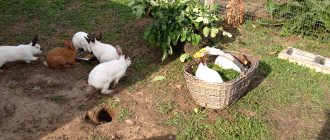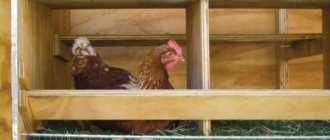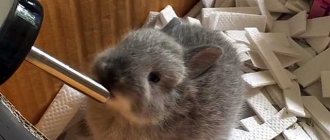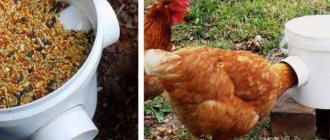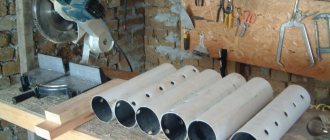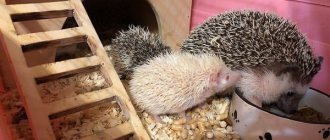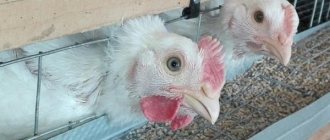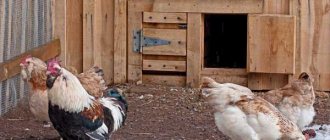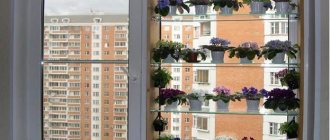DIY Zolotukhin cells
Cages designed by the Russian rabbit breeder Zolotukhin have gained immense popularity due to their simplicity, low cost and ease of caring for the animals.
The advantages of this type of cells include:
- sloped slate or plywood floor with mesh near the back wall;
- three-tier structure of six cells. Shifting the cells to the width of the grid in the floor makes cleaning easier;
- the possibility of arranging a queen cell in a regular cage;
- a specially designed feeder that does not require opening the door when dispensing food;
- low cost.
Improvements adopted by an experienced rabbit breeder-innovator bring the keeping of rabbits closer to the conditions in which they find themselves in their natural habitat.
Design Features
To make a cage for Zolotukhin rabbits, you can use wooden boards and slats, slate sheets, tin, polycarbonate panels, and metal mesh.
The frame of the structure and partitions are made of wood, and the floor and roof are made of flat slate. The doors and a small part of the floor at the back wall are covered with mesh. The wooden structural elements are sheathed with tin to prevent rabbits from chewing them.
Rabbit cage size:
- cage width – 2000 mm;
- height of the three-tier structure – 1500 mm;
- depth – from 700 to 800 mm;
- doors - 400×400 mm;
- floor mesh width – 150-200 mm;
- the difference in the level of the front and rear parts of the floor is from 50 to 70 mm.
Drawings of Zolotukhin cells. Photo
Each of the three levels consists of two cages, separated by two board partitions, between which hay is stored. The floor, also known as the roof for the lower tier, is made of slate. The back part of the floor up to a width of 200 mm is made of mesh. Each upper cell is extended by the same amount relative to the lower one so that feces are removed onto the floor or ground. The back wall is made of polycarbonate and installed in an inclined manner.
Exact dimensions for making cages are not needed; the diagram given by the rabbit breeder is sufficient. This structure is a structure with a queen cell, so for the usual keeping of rabbits, the wall with the opening will need to be replaced with a solid wooden panel.
The queen cell door is not made of mesh, since the nest requires shade and shelter from drafts. To prevent the young animals from falling out when cleaning or feeding, a board 10 centimeters wide is nailed to the front of the shelter.
The design with a fenced-off queen cell makes it easy to expand the space for growing rabbits. To do this, just remove the board partition.
In winter, Zolotukhin installs a queen cell-burrow in the cage. It is a wooden box with an increased height of the back wall. This allows you to create the necessary expansion in the depths of the rabbit hole. The hole in the queen cell is cut out so that there is no threshold between the box and the floor of the cage.
Dimensions of the winter queen cell of Zolotukhin cage for rabbits:
- upper and lower parts – from 300×300 to 400×400 mm;
- front wall – 160 mm;
- rear wall – 260 mm;
- opening height – 150 mm.
The feeder is a long tray that takes up 2/3 of the length of the cage. Its front wall is twice as large as the back wall, and the bottom slopes into the cage at an angle of up to 35?. The feeder is mounted on a rod hinge, which allows you to install the tray in the door. This eliminates the need to open the cage when feeding and makes it easier to clean the feeder from leftover food.
DIY rabbit cages. Video
As you can see, making a rabbit cage with your own hands is quite simple.
At the same time, it is important to ensure the comfort and safety of pets, as well as to provide for ease of feeding and cleaning
Stages of creating a cell according to the drawing
- Let's start by making a wooden cage frame. We will take the size of the frame for medium breeds of rabbits measuring 0.5 by 1 m and a height of 0.5 m
- The base of the cage is made of plywood or OSB3 board, then we cover it with linoleum or a piece of old film. This will be a kind of tray for collecting the animal's urine and feces. It is advisable to make this tray retractable for easy cleaning of the cage.
- The floor of the cage is made of metal mesh with a cell size of 16 by 48 and a rod thickness of at least 2 mm.
- We cover the side walls and top of the cage with metal mesh. The cage door is hinged. It is possible to produce a cage with an opening top. Then making a separate door is not necessary.
Purpose
As can be understood from the above, a rabbit is not an animal that urgently needs a lot of free space. For this reason, many breeders prefer to save space and house the animals as densely as possible. Of course, there are special situations. For example, small rabbits cannot be immediately separated from their mother, and a standard cage cannot accommodate a whole family for one rabbit. For this reason, rabbit cages are divided into several types according to their purpose. If you are serious about breeding, then it is worth having all these types of rabbit homes.
For breeding
In general, such cages can be called standard, because they are intended for fattening and permanent residence of rabbits. Feeding houses can be single-tiered or multi-tiered; they can be located both indoors and outdoors, but taking into account the necessary insulation. Feeders are often built into the doors of such cages, which allows you to give your pet food without opening the door - this greatly reduces the chances of escape.
Breeding cages are often placed in one housing: two per tier. The partition between them can be easily removed - this is necessary to bring together a rabbit couple for which the time has come to reproduce. Since no transplant is necessary, the animal does not experience additional stress and does not have the opportunity to escape.
For the litter
Cages for uterine rabbits require special conditions of detention, if, of course, the owner is concerned about obtaining live and healthy offspring. Unlike the rest of her life, during pregnancy the female is no longer so unpretentious to her environment - it is advisable to provide an environment similar to what it would be in a natural habitat.
The maternity cage is always located inside the utility room, and additional heating is also assumed - this is done using a heating cable or an ordinary light bulb. In this case, the cage should be located near a wall with no windows - it is assumed that the female is in a hole, which means it is relatively warm and dark there. When preparing for childbirth, nothing should tell the rabbit about danger, so the nesting cage should be located in a quiet and peaceful place.
For young animals
Unlike adult rabbits, it is more practical to keep young rabbits together - at least until they outgrow their common cage and become interested in procreation. Consequently, a cage for young animals is the only group housing option, except for an enclosure, where young animals end up from about three months of age.
It is assumed that one cage can contain from 8 to 20 individuals, while each young rabbit should have at least 0.15 square meters of area. Such rabbit cages are made quite high: their ceiling should be at least 35 cm high. Young animals are especially tasty prey for predators, including domestic cats, so in outdoor conditions their home is placed at a height of at least 70 cm from ground level.
For the breed "giants"
Those who breed rabbits for meat highlight only one drawback of these animals - they are quite small. Naturally, breeders have long thought about this problem and have already managed to develop several breeds, among which two can be distinguished: Californian and “giant”. Representatives of both breeds are distinguished by good sizes - “Californians” have an average length of 45-50 cm and a weight of up to 5 kg, and “giants” are absolutely huge - 55-65 cm in length, while weighing from 5.5 to 7. 5 kg. Naturally, both breeds require much larger cages in all cases.
For example, for an ordinary single cage intended for a Californian breed rabbit, the normal size is an area of 0.5 square meters. In the case of a “giant”, the dimensions of the housing can be even more impressive - the minimum requirements are dimensions of 120x80x60 cm.
In one litter, such rabbits produce up to 8 rabbits, and although the number does not seem too large compared to ordinary relatives, the size of the babies also requires an increase in living space to at least 1.2 square meters with a height of 40 cm. Since the animals are of significant weight, the cages for such rabbits of any age, they are usually additionally reinforced with sheet metal.
Dimensions and layout of the cage
Before starting work, it is advisable to decide on the size of the cage and prepare drawings according to which you will make the house
It is important that when drawing up the scheme, not only the number of livestock is taken into account, but also the sex, age and breed of animals
For example, to breed giant rabbits you will need cages larger than the standard size. If you are going to raise representatives of ordinary breeds, then you can build universal houses.
Depending on the main physiological indicators, the cell sizes will be as follows:
- For young animals, a minimum of 0.15 square meters of free space per individual is required. In this case, the width of the house should be 80-100 cm, length 120-150 cm, and height – about 50 cm.
- Adults require more space, about 0.5 square meters per head. The cages themselves are not made so large (width 60-80 cm, length 100 cm and height 35 cm) so that the animals gain weight faster.
- When keeping several adult rabbits in one cage, the size of the house is slightly increased to prevent fights between animals. In this case, the width of the house will be 80-100 cm, the length is about 150 cm, and the height is 40-50 cm.
Figure 3. Options for cell drawings
You can draw up a drawing yourself, but if you are afraid that you will not be able to carry out all the calculations correctly, it is better to use ready-made diagrams from the Internet. In this case, you can find not only a drawing of a summer house, but also diagrams for making comfortable winter cages (Figure 3).
Purpose and device
A rabbitry is a structure equipped with cages and enclosures, which is intended for raising rabbits. Such structures are installed both outdoors and in closed utility rooms. Since rabbits are demanding in terms of care, rabbit hutches need to be built with good heating, lighting and ventilation. As a rule, cages for rabbits are installed in two or three tiers, and if the cottage is located in an area with a warm climate, then experts recommend placing such structures on the street, protecting them with a canopy.
In order for animals to feel comfortable, the rabbitry must meet the following requirements:
- provide animals with all the necessary conditions for growth and reproduction;
- be equipped with special enclosures for young offspring;
- have a width and height that would allow animals to move freely;
- be equipped with a convenient cleaning system.
Rabbits need conditions that would promote their rapid reproduction, development and good health.
When arranging a rabbitry, it is important to consider the following parameters
- Temperature conditions. The optimal temperature for this type of animal is considered to be +16 degrees. If the cages are placed near doors and windows, then additional heating will have to be provided, since hypothermia is bad for the health of rabbits. In addition, at low temperatures, more feed will be required, which, in turn, will cause additional costs. Therefore, it would be best to build a recessed rabbitry, with good ventilation and heating. Roofing material also plays a huge role in insulation; it must be strong, thick and protect the structure from moisture and drafts.
- Air humidity. In the rabbitry, the humidity should be constantly maintained at a level of at least 75%. The rooms in which the cages are located must also be periodically ventilated, which will allow gases released from feces and urine to escape. To do this, install a metal exhaust pipe with an adjustable ventilation system in the room.
- Access to cleaning. Cages should be cleaned several times a week to make waste disposal easier. The rabbitry must be equipped with special assembly grooves.
- Lighting. The density, quality of fur and growth rate of pets directly depend on the length of daylight hours. Since these animals are more active at night, the cages should receive good lighting. In this case, it is best to keep the brightness of the light moderate. For example, for adults the lighting standard is 70 lux, and for young animals - 30. As for the duration of daylight, it should be at least 18 hours. In this regard, in winter the rabbitry is additionally equipped with lighting in the form of several lamps.
How to crate train a rabbit
If the cage is comfortable, the rabbit will get used to it quickly enough
In their natural environment, rabbits live in burrows. When keeping animals productively, providing them with adequate privacy is very difficult. If a rabbit hutch is not constructed correctly, has sharp interior edges, is small in space, or is located in a noisy environment, the animals will experience stress that will adversely affect their health and reproductive performance.
Accustoming a rabbit to a new home is quite simple: you just need to provide it with the most comfortable living conditions.
Rabbit breeding is a popular and profitable business in rural areas. Animals are kept in special cages that you can make yourself. Using the information and tips from this article, anyone, even the most inexperienced rabbit breeder, will be able to design the right cage that is ideal for their rabbits.
Location of the cage in an apartment or house
Rabbit dandruff
It is recommended not to place the cage where there is direct sunlight or drafts. You need to place it in a shaded place, away from open windows and doors that are often walked through.
On a note. One of the most convenient places for a baby rabbit to live is the bedroom. There are rarely strangers there.
If it is difficult to find a completely suitable place, it is enough to choose the quietest and most peaceful corner that can be found in the house. The rabbit likes silence during the day; loud noise will frighten him and can cause stress. A too restless environment may well shorten his lifespan.
Types of cells
When arranging a cage, not only the dimensions and material of manufacture are taken into account
The future specialization of the rabbit house is important
By design
Three main types of structures are most widespread:
- Stationary external insulated enclosures with paths connected to them for servicing and feeding animals. Such cages are protected on all sides from wind, cold and rain.
- Mobile outdoor lightweight enclosures for moving around the site throughout the year. This option is chosen if there is no place where the sun shines equally well all year round.
- Stationary lightweight cages for installation in a furnished barn.
Regardless of the installation location, enclosures are built on one, two or three floors to save space. Multi-storey structures are called sheds.
By purpose
In the arsenal of an experienced rabbit breeder there are always cages for the uterus, individual and collective housing. The most common cells are for:
- Collective maintenance of young animals that have not yet gained weight, but no longer need their mother. Before moving in, animals are separated by weight and size to avoid injury.
- Individual housing for adults, especially aggressive males, with reinforced floors and partitions.
- Females with offspring with a built-in queen cell, so as not to disturb the pregnant rabbit.
When creating a rabbitry, certain standards must be met
The most common design options
There are many different options, from which each farmer chooses the most suitable one depending on available resources, free space and other parameters. The following designs are very popular among breeders:
- solid wire;
- Mikhailova;
- Zolotukhina;
- Tsvetkova.
Solid wire
This is the most budget-friendly housing option that can be placed in any convenient location. Such cages are lightweight and durable, they take up little space and are easy to care for on a daily basis.
All-wire construction is easy and practical to maintain
For production, two types of galvanized mesh with cells of different sizes are required. The coarse mesh (2.5-5x5 cm) is attached to the walls and ceiling, and the fine mesh (1.5-2.5 cm) is attached to the floor. The frame is made of durable timber, with legs 50-70 cm high. In the warm season, the structure is installed outside (under a canopy); in cold weather, it is brought into an insulated shed.
You can see step-by-step instructions on how to quickly make a simple all-wire dwelling for rabbits in the following story:
Mikhailova
A distinctive feature of the design, made according to Mikhailov’s drawings, is the heating of the queen cell and drinkers, and the presence of a container for collecting waste. Cells of this type can be one- or two-level. House dimensions: width 240 cm, height 70 or 210 cm (depending on number of floors). The distance from the ground to the structure is 140 cm - this space is necessary to place a special inclined chute and waste collector.
An additional queen cell (size 35×40 cm) is sometimes attached to the back wall, and feeders (30×15 cm) are attached to the side walls.
Drawing of a cage for rabbits of one of the common types of Mikhailov’s design
The floor is made of slats, which are laid at small intervals. This allows waste to flow down the gutters into a special container. The walls are made of wood, the doors are made of mesh. For better air flow, the home is equipped with a ventilation pipe covered with a canopy.
Automatic heating technologies are most often used when breeding ornamental breeds, since the cost of such equipment for the house and its maintenance is too high.
Zolotukhina
N.I. Zolotukhin is known in rabbit breeding circles as the creator of a simple and inexpensive design for placing eared ears. The original layout of the home allows for less frequent cleaning, and the animals feel more comfortable.
Such houses are multi-story buildings with a sloping plywood ceiling. The floor is made of mesh, which is laid in a thin strip against the back wall. The second tier is shifted relative to the lower one by the width of the mesh strip. The third floor is located similarly. The front wall, common to all three tiers, is attached at an angle.
Houses for rabbits, equipped according to Zolotukhin’s drawings, look unusual, but are practical and easy to use when placed outdoors
In the process of creating such a home, you need to follow step-by-step instructions. First of all, you should purchase wooden beams and boards, slate sheets, metal mesh, polycarbonate and metal sheets. The frame, partitions and doors of the queen cell are constructed from wood. The mesh is used for doors and the back of the floor. The rest of the bottom is made of slate. The back wall is made of polycarbonate. The wooden surfaces inside are sheathed with tin.
Standard dimensions of a cage for rabbits according to Zolotukhin’s drawings:
| Parameter | Size, cm |
| Height | 150 |
| Width | 200 |
| Depth | 70-80 |
| Floor tilt | 6-8 |
| Width of mesh strip in front of rear wall | 15-20 |
| Doors | 40x40 |
You can learn about the advantages of a home of this design from the following video:
Tsvetkova
Experienced rabbit breeder A. A. Tsvetkov proposed a new original idea for a cage, the main valuable features of which were:
- gravity feeders;
- mounted queen cells;
- forced ventilation;
- feces removal system.
The frame is constructed from coniferous timber, which is usually painted with white paint. The sennik is made of moisture-resistant plywood, at least 8 mm thick, and the inside is lined with metal mesh. All wooden parts are sheathed with sheet metal, the cone-shaped compartment for drainage and waste collection is covered with slate mastic. The roof is covered with slate or roofing felt.
Structures made according to Tsvetkov’s drawings are distinguished not only by their original appearance, but also by their high practicality
To heat water in the cold season, the house is equipped with a special boiler.
Why does a rabbit chew on a cage: what to do
The answer to this question is obvious, because a rabbit is a rodent.
Considering that the average lifespan of decorative rabbits is 7-8 years, their teeth should reach almost a meter in length by old age! Naturally, this does not happen for the simple reason that these teeth are constantly worn down.
The digestive system of a rodent is designed in such a way that it eats the main part of its life: the normal number of meals per day for a rabbit is 25-30 times!
In the wild, the animal is forced to use pasture for food, which is not always soft and tender. To fill their stomachs and intestines, the animals constantly gnaw on branches, plant roots and bark, thus grinding down their “working tools.”
A happy, well-fed life at home deprived animals of the need to get their own food, but created an unexpected problem: the ability to quickly grow teeth, inherent in nature as a prerequisite for survival, began to cause a real inconvenience.
Incorrect feeding with a predominance of soft food (greens, vegetables, hay) leads to the fact that in the absence of the required load, the teeth begin to itch unbearably, and even grow so large that it becomes difficult for the animal to close its mouth.
Did you know? One Chinese farmer living in the eastern province of Jiangsu, Huai'an City, presented the world with a real "saber-toothed" rabbit. The animal received only soft food for food, as a result, one of its lower incisors grew so large that it literally curled around the nose of the unfortunate rodent.
The habit of decorative rabbits to frantically chew the bars of their cage has nothing to do with planning an escape. The main reason is itchy teeth.
It is easy to eliminate this problem: the cage should always contain so-called “chews” - hard wooden objects, twigs, chalk (it is also needed as a source of phosphorus and calcium necessary for the animal), and other objects that can sharpen overgrown incisors.
Zoological stores offer a huge selection of suitable treats and toys.
If a rabbit not only gnaws, but also intensively licks elements of the cage’s structure, this may indicate a lack of mineral salts in its diet (the animal intuitively tries to get them from its own urine, which somehow saturates the bottom and walls of the house).
In any case, a properly selected and balanced diet for a rabbit will help avoid damage to its own home.
How to set up a cage for a decorative rabbit
Feeders
It is very important that the feeding area in the rabbit’s home is clearly marked. You can use the following as a feeder:
- a metal bowl with a heavy bottom (so that the baby cannot turn it over);
- a plastic container that is attached to the wall of the house;
- hay manger (if hay or straw is scattered on the floor, the rabbit will most likely perceive it not as a treat, but as a large toilet).
Iron feeders
DIY feeder
Hay box for rabbit
Drinking bowls
A regular bowl filled with water can serve as a drinking bowl. The main thing is that the animal always has access to it.
However, many breeders recommend installing nipple sippy cups. The principle of their operation is based on the fact that when the rabbit presses the valve, water begins to flow drop by drop from the mechanism. Using such a system ensures that the cage will always be dry and clean.
Drinker with nipple ball
Tray
The key is to train the animal to use the tray. It is advisable that you have two of them. One directly in the cage, the second outside it. You can use a plastic box with low sides, a tray with a grid for a cat, or a specialized tray for rabbits.
It is important to secure it at the base of the cage
Rabbit in a tray
To fill the toilet, use finely torn newspaper or commercial compressed wood or corn mixture. Cat litter is suitable, provided it is covered with a fine grid.
But pine sawdust is absolutely not suitable for rabbits.
It's pretty quick to train your rabbit to use the litter box. To indicate for kids where the toilet is in their new home, it is better to put some rabbit droppings there.
Litter
Whether it is worth using bedding on the cage floor is something each rabbit owner decides for himself, as well as what material it is best to make it from.
The most common options are:
- sawdust;
- hay;
- polymer bath mat;
- corrugated cardboard;
- newspaper or paper.
Each of these options has its own advantages and disadvantages. But at the same time, by abandoning the floor covering, there is a risk of the rabbit developing pododermatitis on its paws.
Shelter
In nature, rabbits live in burrows, so babies need to have a place at home that is protected from prying eyes.
In some cage models, such a shelter is included. But a small cardboard box is also suitable for these purposes. The fluffy will feel protected in it, but will also be able to arrange it to his liking (gnaw through the windows, enlarge the entrance). True, after a couple of months such shelter will need to be replaced with a new one. But such vigorous activity has a positive effect on the animal’s psyche.
Possible problems
A rabbit needs a well-ventilated home. Therefore, cage options with plastic walls are not suitable. The cage should be high enough so that the rabbit, standing on its hind legs, can straighten its ears freely. The design must have enough space to allocate feeding, resting and toilet areas.
It is not recommended to choose products with enameled metal elements, since a rabbit can chew the coating. If there is no separate door on the second floor, then getting the rabbit out will be problematic.
